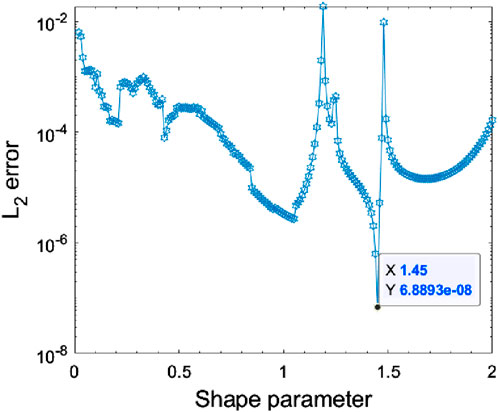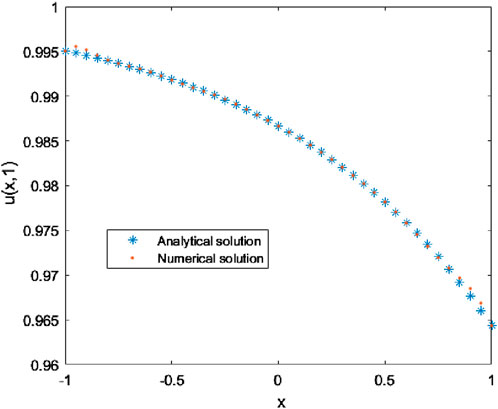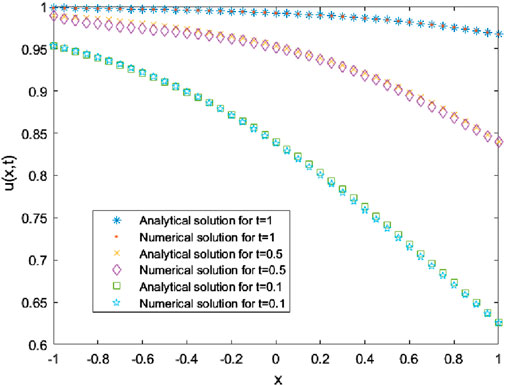- 1Institute of Data Science and Engineering, Xuzhou University of Technology, Xuzhou, China
- 2School of Mathematics and Statistics, Huaibei Normal University, Huaibei, China
This study introduces a relatively new numerical technique for solving one-dimensional Fisher’s equation. The proposed numerical technique is a simple direct meshless method, which is based on the collocation scheme. To circumvent the traditional two-level numerical procedure, the space-time radial basis function is considered. Under such circumstances, the time-dependent one-dimensional nonlinear Fisher’s equation can be solved by a one-level numerical procedure. Several numerical results are investigated to show advantages of the proposed meshless method.
1 Introduction
The application areas of nonlinear fisher’s equation include biology [1], ecology [2] cancer research [3], chemistry [4], etc. It continues to serve the spatiotemporal dynamics modeling of complex systems, and in the future, it will deeply intersect with cutting-edge fields such as quantum computing and synthetic biology. As a classic reaction-diffusion model, the nonlinear fisher’s equation has the following form
Here,
Numerical simulation of Fisher’s equation has made significant progress driven by computational power, algorithm innovation, and interdisciplinary demands [5]. Traditional methods include the finite difference method [6], the finite element method [7], and coupled numerical methods based on traditional methods [8–10]. By using generalized Hermite interpolation, a fully discrete pseudospectral scheme is presented for Fisher’s equation [11]. Geeta and Varun [12] investigated trigonometric B-spline collocation method to simulate the 1-D Fisher’s equation. A hybrid numerical method [13], which is composed by cubic trigonometric B-spline base functions and differential quadrature method, is proposed for the numerical solution of Fisher’s reaction-diffusion equation. Based on the finite difference method and wavelet Galerkin method, Haifa [14] proposed an algorithm to simulate the Fisher’s equation. The Haar wavelet method is applied to obtain the approximate solution for the Fisher’s equations by Sakina et al. [15]. Based on Barycentric Rational interpolation, Mittal and Rohila [16] proposed a numerical approach to simulate the Burgers’ and Fisher’s equations.
Since the radial-basis-function-based collocation methods are truly meshless numerical methods, they are widely used in solving partial differential equations and analyzing complex engineering problems. The effectiveness of the BKM is investigated for solving Helmholtz-type problems under various conditions through a series of novel numerical experiments [17]. Based on the method of fundamental solutions, a high-accuracy and efficient method is provided for addressing antiplane piezoelectricity problems with multiple inclusions [18]. A new meshfree method is proposed for heat transfer problems in porous material energy storage battery [19].
Some investigations have been performed by using radial-basis-function-based methods to simulate Fisher’s equation. Based on the global radial basis function method, Zhang et al. [20] proposed a two-level radial basis function-finite difference method for solving nonlinear Fisher’s equation. A novel meshless local collocation method is proposed for the numerical solution of the 3-D extended Fisher-Kolmogorov equation [21]. In combination with the pseudo-spectral method, Geeta et al. [22] used the radial basis function to get the numerical solution of Fisher’s equation. Along with the radial basis functions, particle swarm optimisation algorithm is used to obtain the numerical solutions of the Fisher’s equation [23].
As mentioned in the previous-analysis, there are some investigations related to the meshless method for Fisher’s equation. However, these numerical methods are two-level numerical methods. The meshless method should be accompanied with the other numerical methods to deal with time-dependent term in the governing equation. To seek for an alternative way, we propose a one-level meshless method for Fisher’s equation. By using a space-time formulation, the time-dependent term can be treated as space-dependent term. The initial and boundary conditions for Fisher’s equation are given as
Here,
The rest of this paper is organized as follows. Section 2 provides a brief description of the one-level meshless method. Numerical examples are provided in Section 3 and some concluding remarks are given in Section 4.
2 The one-level meshless methods
As is known to all, the time-dependent problems Equations 1, 2 are always solved by using two-level numerical methods. The finite difference scheme or integral transform method should be employed to deal with the time-dependent term, and the resulting elliptic-type problems are solved by the other numerical methods. There are two aspects in the accumulation of errors of two-level methods, i.e., the finite difference step and the numerical method step.
To find an alternative to the two-level method, a one-level direct meshless method is proposed in this section. The one-level direct meshless method is based on space-time radial basis functions (RBFs). Under such one-level meshless method, there’s only one aspect in the accumulation of errors.
2.1 The space-time RBFs
RBFs are a type of scalar function based on distance measurement, whose core characteristic is that the function value only depends on the distance from the two points. The advantages of RBFs include local response characteristics, efficient processing of sparse or high-dimensional data, simple mathematical form, easy-to-implement, and parallel computing.
For 2D steady-state problems, the commonly-used RBFs include three types, the detailed formula is shown in Equation 3
Here,
Since there is only one space variable in Fisher’s Equation 1, we consider the time variable “equally” as a new space variable. More specifically, the Fisher’s equation is considered as a “equally” steady-state equation. The corresponding space-time RBFs has the form
Here,
2.2 Implementation of the one-level meshless method
Before implementation of the one-level meshless method, collocation points should be provided. More specifically, the space variable interval
According to the basic theory of collocation methods, the approximate solution of the function
with
To illustrate the one-level meshless method, we substitute Equation 6 into Equations 1, 2 at space-time points
Here, the operator is shown in the following Equation 8
For multiquadric RBF
In order to obtain a square interpolation matrix, we consider
where
Equation 9 can be directly solved to get the unknowns
3 Numerical simulations
In the following numerical examples, the multiquadrics RBF in Equation 4 is used to illustrate the numerical results. We use the
3.1 Example 1
For the constant diffusion coefficient
The corresponding exact solution is
The corresponding initial condition and boundary condition can be deduced from Equation 14.
At time
3.2 Example 2
Here, we consider the following Fisher’s equation as shown in Equation 15
The corresponding exact solution is shown in Equation 16
The quasi-optimal choice of shape parameter is the same as Example 4.1. For shape parameter
3.3 Example 3
In this example, we consider the following Fisher’s equation as shown in Equation 17
The corresponding analytical solution is shown in Equation 18
At time
4 Conclusion
This study introduces a novel one-level meshless method for solving the one-dimensional nonlinear Fisher’s equation, leveraging space-time radial basis functions (RBFs). The key findings are summarized as follows:
• The use of space-time RBFs eliminates the requirement for the traditional two-level numerical procedure (e.g., separate time-stepping and spatial discretization), significantly reducing computational complexity.
•The meshless nature of the method avoids reliance on structured grids, making it suitable for problems with complex geometries or dynamic boundaries.
•Numerical experiments demonstrate that the method achieves high accuracy (e.g., compared to analytical solutions) while maintaining low computational costs, particularly for long-term simulations.
In conclusion, the proposed one-level meshless method provides an efficient and flexible numerical tool for solving time-dependent partial differential equations, particularly in terms of simplifying procedures. As a meshfree collocation method, the proposed method has similar limitations with the other collocation methods. Substantial theoretical groundwork, particularly regarding convergence and stability in generalized frameworks, remains unexplored. These aspects will be systematically investigated in future studies.
Data availability statement
The original contributions presented in the study are included in the article/Supplementary Material, further inquiries can be directed to the corresponding authors.
Author contributions
YJ: Validation, Data curation, Funding acquisition, Conceptualization, Supervision, Writing – original draft. FW: Writing – review and editing, Validation, Writing – original draft, Software, Visualization, Conceptualization, Investigation, Methodology. ZS: Conceptualization, Writing – original draft, Writing – review and editing, Resources, Validation, Formal Analysis, Visualization, Data curation.
Funding
The author(s) declare that financial support was received for the research and/or publication of this article. This work is partially supported by University Natural Science Research Project of Anhui Province (Project No. 2023AH050314) and Horizontal Scientific Research Funds in Huaibei Normal University (No. 2024340603000006).
Conflict of interest
The authors declare that the research was conducted in the absence of any commercial or financial relationships that could be construed as a potential conflict of interest.
Generative AI statement
The author(s) declare that no Generative AI was used in the creation of this manuscript.
Publisher’s note
All claims expressed in this article are solely those of the authors and do not necessarily represent those of their affiliated organizations, or those of the publisher, the editors and the reviewers. Any product that may be evaluated in this article, or claim that may be made by its manufacturer, is not guaranteed or endorsed by the publisher.
Supplementary material
The Supplementary Material for this article can be found online at: https://www.frontiersin.org/articles/10.3389/fphy.2025.1616647/full#supplementary-material
References
1. Drábek P, Takáč P. Convergence to travelling waves in Fisher’s population genetics model with a non-Lipschitzian reaction term. J Math Biol (2017) 75:929–72. doi:10.1007/s00285-017-1103-z
2. Bruzzone OA, Utgés ME. Analysis of the invasion of a city by Aedes aegypti via mathematical models and Bayesian statistics. Theor Ecol (2022) 15:65–80. doi:10.1007/s12080-022-00528-y
3. Macías-Díaz JE. Conciliating efficiency and dynamical consistency in the simulation of the effects of proliferation and motility of transforming growth factor β on cancer cells. Commun Nonlinear Sci (2016) 40:173–88. doi:10.1016/j.cnsns.2016.03.018
4. Mittal RC, Rohila R. A study of one dimensional nonlinear diffusion equations by Bernstein polynomial based differential quadrature method. J Math Chem (2017) 55:673–95. doi:10.1007/s10910-016-0703-y
5. Bui TTH, van Heijster P, Marangell R. Stability of asymptotic waves in the Fisher–Stefan equation. Physica D (2024) 470:134383. doi:10.1016/j.physd.2024.134383
6. Deng D, Hu M. Non-negativity-preserving and maximum-principle-satisfying finite difference methods for Fisher’s equation with delay. Math Comput Simulat (2024) 219:594–622. doi:10.1016/j.matcom.2024.01.013
7. Devi A, Yadav OP. Analysis and simulation of the (2 + 1)-dimensional Fisher’s reaction-diffusion equation with higher order finite element method. Numer Heat Tr B- Fund (2024) 1–25. doi:10.1080/10407790.2024.2360637
8. Zorsahin GM, Dag I. Exponential B-splines Galerkin method for the numerical solution of the Fisher’s equation. Iran J Sci Technol Trans Sci (2018) 42:2189–98. doi:10.1007/s40995-017-0403-x
9. Kırlı E, Irk D. Efficient techniques for numerical solutions of Fisher’s equation using B-spline finite element methods. Comp Appl Math (2023) 42:151. doi:10.1007/s40314-023-02292-z
10. Saad KM, Khader MM, Gómez-Aguilar JF, Baleanu D. Numerical solutions of the fractional Fisher’s type equations with Atangana-Baleanu fractional derivative by using spectral collocation methods. Chaos (2019) 29:023116. doi:10.1063/1.5086771
11. Wang T, Jiao Y. A fully discrete pseudospectral method for Fisher's equation on the whole line. Appl Numer Math (2017) 120:243–56. doi:10.1016/j.apnum.2017.06.002
12. Geeta A, Varun J. A computational approach for solution of one dimensional parabolic partial differential equation with application in biological processes. Ain Shams Eng J (2018) 9:1141–50. doi:10.1016/j.asej.2016.06.013
13. Mohammad T, Neeraj D, Vineet KS. Cubic trigonometric B-spline differential quadrature method for numerical treatment of Fisher’s reaction-diffusion equations. Alex Eng J (2018) 57:2019–26. doi:10.1016/j.aej.2017.05.007
14. Haifa BJ. On the numerical solution of Fisher's equation by an efficient algorithm based on multiwavelets. AIMS Math (2021) 6:2369–84. doi:10.3934/math.2021144
15. Sakina S, Rohul A, Nadeem H, Ali A. Numerical solution of Fisher’s equation through the application of Haar wavelet collocation method. Numer Heat Tr B- Fund (2024) 1–12. doi:10.1080/10407790.2024.2348129
16. Mittal RC, Rohila R. A numerical study of the Burgers’ and Fisher’s equations using barycentric interpolation method. Int J Numer Method H (2023) 33:772–800. doi:10.1108/hff-03-2022-0166
17. Wang F, Zheng K, Li C, Zhang J. Optimality of the boundary knot method for numerical solutions of 2D Helmholtz-type equations. Wuhan Uni J Nat Sci (2019) 24 (4):314–320. doi:10.1007/s11859-019-1402-x
18. Zhang J, Lin J, Wang F, Gu Y. Simulation of antiplane piezoelectricity problems with multiple inclusions by the meshless method of fundamental solution with the LOOCV algorithm for determining sources. Mathematics-Basel (2025) 13:920. doi:10.3390/math13060920
19. Lin Y, Wang F. A space-time meshfree method for heat transfer analysis in porous material. Phys Scripta (2024) 99:115274. doi:10.1088/1402-4896/ad8680
20. Zhang X, Yao L, Liu J. Numerical study of Fisher’s equation by the RBF-FD method. Appl Math Lett (2021) 120:107195. doi:10.1016/j.aml.2021.107195
21. Ju B, Qu W. Three-dimensional application of the meshless generalized finite difference method for solving the extended Fisher–Kolmogorov equation. Appl Math Lett (2023) 136:108458. doi:10.1016/j.aml.2022.108458
22. Geeta A, Kiran B, Homan E, Masoumeh K. A comparative study of particle swarm optimization and artificial bee colony algorithm for numerical analysis of Fisher’s equation. Discrete Dyn Nat Soc (2023) 2023:9964744.
23. Kiran B, Geeta A, Homan E, Masoumeh K. Applications of particle swarm optimization for numerical simulation of Fisher’s equation using RBF. Alex Eng J (2023) 84:316–22.
24. Chen W, Hong YX, Lin J. The sample solution approach for determination of the optimal shape parameter in the Multiquadric function of the Kansa method. Comput Math Appl (2018) 75:2942–54. doi:10.1016/j.camwa.2018.01.023
25. Zhang J, Wang F, Nadeem S, Sun M. Simulation of linear and nonlinear advection-diffusion problems by the direct radial basis function collocation method. Int Commun Heat Mass (2022) 130:105775. doi:10.1016/j.icheatmasstransfer.2021.105775
26. Zhang Z, Wang F. The space-time semi-analytical meshless methods for coupled Burgers' equations. Wuhan Univ J Nat Sci (2024) 29:572–8. doi:10.1051/wujns/2024296572
Keywords: Fisher’s equation, meshless method, one-level method, radial basis function, numerical simulation
Citation: Jiang Y, Wang F and Sun Z (2025) Numerical solutions of the nonlinear Fisher’s equation using a one-level meshless method. Front. Phys. 13:1616647. doi: 10.3389/fphy.2025.1616647
Received: 23 April 2025; Accepted: 10 June 2025;
Published: 24 June 2025.
Edited by:
Fei Yu, Changsha University of Science and Technology, ChinaCopyright © 2025 Jiang, Wang and Sun. This is an open-access article distributed under the terms of the Creative Commons Attribution License (CC BY). The use, distribution or reproduction in other forums is permitted, provided the original author(s) and the copyright owner(s) are credited and that the original publication in this journal is cited, in accordance with accepted academic practice. No use, distribution or reproduction is permitted which does not comply with these terms.
*Correspondence: Fuzhang Wang, d2FuZ2Z1emhhbmcxOTg0QDE2My5jb20=; Zhongyang Sun, c3Vuemhvbmd5YW5nMUAxNjMuY29t
 Yingzi Jiang1
Yingzi Jiang1 Fuzhang Wang
Fuzhang Wang


